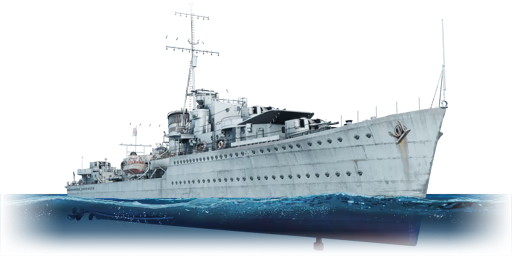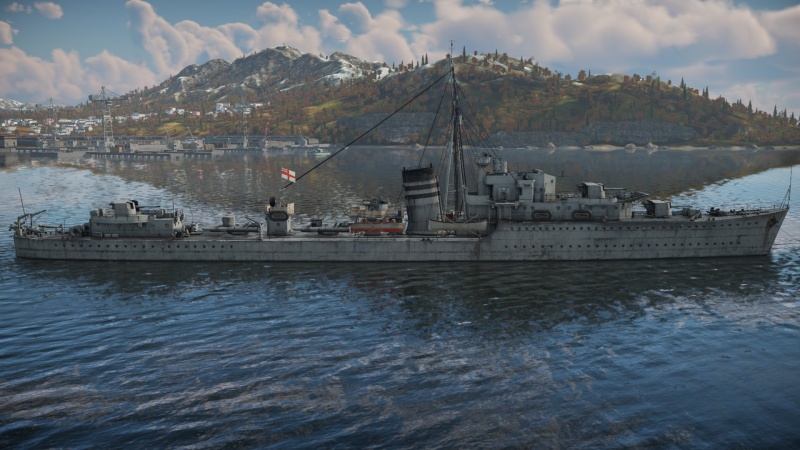HMS Kelvin
Contents
Description
The K-class, HMS Kelvin (F37), 1939 is a rank II British destroyer with a battle rating of 4.3 (AB/RB/SB). It was introduced in Update 1.95 "Northern Wind".
General info
Survivability and armour
Talk about the vehicle's armour. Note the most well-defended and most vulnerable zones, e.g. the ammo magazine. Evaluate the composition of components and assemblies responsible for movement and manoeuvrability. Evaluate the survivability of the primary and secondary armaments separately. Don't forget to mention the size of the crew, which plays an important role in fleet mechanics. Save tips on preserving survivability for the "Usage in battles" section. If necessary, use a graphical template to show the most well-protected or most vulnerable points in the armour.
Mobility
Write about the ship's mobility. Evaluate its power and manoeuvrability, rudder rerouting speed, stopping speed at full tilt, with its maximum forward and reverse speed.
Modifications and economy
Armament
Primary armament
Provide information about the characteristics of the primary armament. Evaluate their efficacy in battle based on their reload speed, ballistics and the capacity of their shells. Add a link to the main article about the weapon: {{main|Weapon name (calibre)}}. Broadly describe the ammunition available for the primary armament, and provide recommendations on how to use it and which ammunition to choose.
Secondary armament
Some ships are fitted with weapons of various calibres. Secondary armaments are defined as weapons chosen with the control Select secondary weapon. Evaluate the secondary armaments and give advice on how to use them. Describe the ammunition available for the secondary armament. Provide recommendations on how to use them and which ammunition to choose. Remember that any anti-air armament, even heavy calibre weapons, belong in the next section. If there is no secondary armament, remove this section.
Anti-aircraft armament
An important part of the ship's armament responsible for air defence. Anti-aircraft armament is defined by the weapon chosen with the control Select anti-aircraft weapons. Talk about the ship's anti-air cannons and machine guns, the number of guns and their positions, their effective range, and about their overall effectiveness – including against surface targets. If there are no anti-aircraft armaments, remove this section.
Additional armament
Describe the available additional armaments of the ship: depth charges, mines, torpedoes. Talk about their positions, available ammunition and launch features such as dead zones of torpedoes. If there is no additional armament, remove this section.
Usage in battles
Describe the technique of using this ship, the characteristics of her use in a team and tips on strategy. Abstain from writing an entire guide – don't try to provide a single point of view, but give the reader food for thought. Talk about the most dangerous opponents for this vehicle and provide recommendations on fighting them. If necessary, note the specifics of playing with this vehicle in various modes (AB, RB, SB).
Pros and cons
Summarise and briefly evaluate the vehicle in terms of its characteristics and combat effectiveness. Mark its pros and cons in the bulleted list. Try not to use more than 6 points for each of the characteristics. Avoid using categorical definitions such as "bad", "good" and the like - use substitutions with softer forms such as "inadequate" and "effective".
Pros:
Cons:
History
The K Class, HMS Kelvin (F37) was a British destroyer of the K class, built for the Royal Navy during the Second World War. Designed as a follow up to the preceding ‘J’ class, the ship was designed as a Tribal class destroyer with more focus on guns and less focus on Torpedoes. HMS Kelvin was laid down in October of 1937 and commissioned by November of 1939. She saw some service during the Second World War, including the task of transporting British Prime Minister Winston Churchill across the English Channel after the D-Day invasion. HMS Kelvin survived the war, and was scrapped by 1949.
Design
The J, K and N class (don’t worry about L and M) destroyers were a group of three classes of destroyers built as a follow up to the preceding Tribal class. At that point in time, the British Admiralty experienced a shift in destroyer doctrine which favoured guns over torpedoes - this trend was continued through the war until the introduction of the Battle class. The HMS Kelvin was armed with a main armament of three twin 4.7 inch (119 mm) QF Mark XII dual-purpose main guns, with two fore and one aft. She also carried a secondary armament of a single quad pom-pom anti aircraft gun, along with two quadruple 12.7 mm anti-aircraft machine guns. HMS Kelvin did not carry any torpedo tubes, but could carry depth charges for anti-submarine warfare. Powered by steam turbines delivering 44 000 shp, she could make 36 knots (67 km/h).
Operational History
The HMS Kelvin was commissioned by November of 1939 and entered service with the British Navy in the British 5th Destroyer Flotilla. She would later scuttle the destroyer HMS Ivanhoe after she had struck a mine during the Texel disaster. She escorted the battleship HMS Revenge as she bombarded the port of Cherbourg, and was subsequently reassigned to the British Mediterranean fleet under Admiral James Somerville.
After arriving in the Mediterranean theatre, HMS Kelvin’s first action was to bombard the town of Benghazi with her sister ships Kashmir, Kelly and Kipling. She survived this action with little loss of life, but needed repairs and was thus sent all the way to Bombay in India. By March 1942, she had returned to the Mediterranean, and took part in the Second Battle of Sirte, where her convoy was attacked by a formidable Italian force including the battleship Littorio.
Later in 1942, Kelvin contributed to the sinking of the Italian torpedo boat Lupo, alongside the J-class destroyers Jervis, Janus and Javelin. In January of 1943, she bombarded the port city of Zuwara which culminated in the Battle off Zuwara, where the destroyers sank an Italian convoy attempting to evacuate from Tripoli. She then left the Mediterranean theatre yet again, to be refitted back in the UK. In June of 1944, she transported the British Prime Minister Winston Churchill, along with various other foreign leaders, across the English Channel to inspect the troops that had landed in the D-Day landings. She then returned to the Mediterranean theatre, where she would stay for the rest of the war. HMS Kelvin survived the war and was broken up for scrap in 1949; she earned eight battle stars for her service during the Second World War.
Media
Excellent additions to the article would be video guides, screenshots from the game, and photos.
See also
Links to articles on the War Thunder Wiki that you think will be useful for the reader, for example:
- reference to the series of the ship;
- links to approximate analogues of other nations and research trees.
External links
References
- Mason, G. B. (2004). HMS Kelvin, Destroyer. Retrieved January 19, 2021, from https://www.naval-history.net/xGM-Chrono-10DD-39K-HMS_Kelvin.htm
- Helgason, G. (1995). HMS Kelvin (F37). Retrieved January 19, 2021, from https://uboat.net/allies/warships/ship/4458.html
| Britain destroyers | |
|---|---|
| Town-class | HMS Churchill · HMS Montgomery |
| V-class | HMS Valhalla · HMS Vega · HMS Verdun |
| G-class | HMS Grafton · ORP Garland |
| Hunt-class | HMS Calpe · HMS Brissenden |
| Tribal-class | HMCS Haida · HMS Eskimo · HMS Mohawk |
| J-class | HMS Jervis |
| K-class | HMS Kelvin |
| N-class | HMAS Nepal |
| Battle-class | HMS Armada · HMS Cadiz · HMAS Tobruk |
| Daring-class | HMS Daring · HMS Diamond · HMS Diana |





